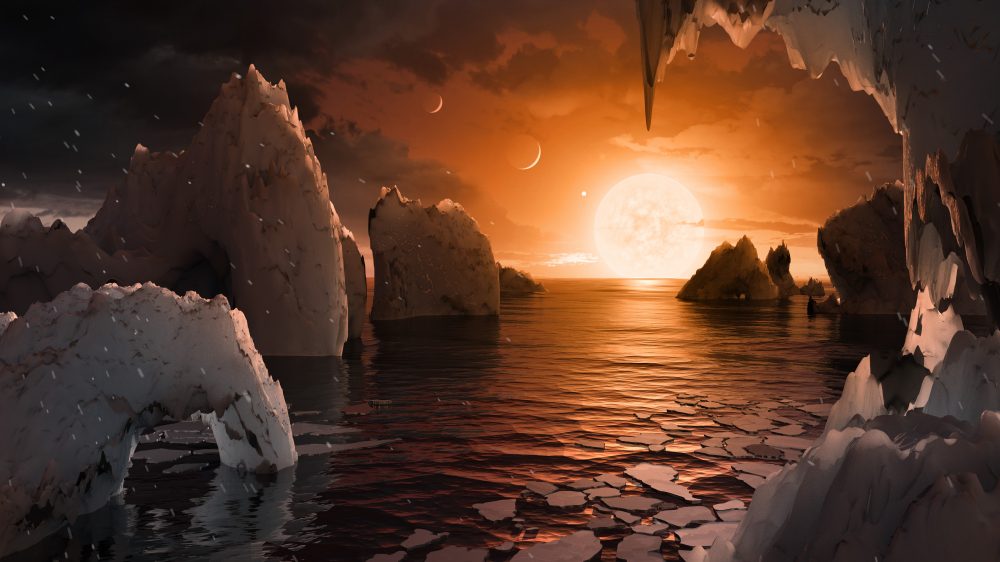Advertisement
Astronomers Discover 7 Earth-Size Planets That May Be Habitable
Resume
Astronomers have discovered seven Earth-size planets orbiting a dwarf star — called TRAPPIST-1 — just 40 light years from Earth. That's 235 trillion miles, which is pretty close in cosmic terms.
At least three of the planets are in what's known as the habitable zone, meaning they could have liquid water and the right conditions for life. Here & Now's Jeremy Hobson talks with Doug Hudgins, program scientist for NASA's Exoplanet Exploration Program, about the TRAPPIST-1 system.
Interview Highlights
On how exciting the discovery is
"This is really exciting because it has to do with worlds that are actually really the size of the Earth. We've found over the last five or six years that planets are tremendously abundant, that when you look up at the night sky and see the stars, basically every start that you're looking at has at least one planet around it and probably more than that. But the majority of the planets that we've found so far have been large planets, the size of Jupiter or even Neptune in our own planetary system. Just because they're bigger, they're easier to find. Earth-sized planets are more tricky. They're small, but they're also the most exciting ones because, of course, we believe that in order for life to exist, you need to have a planet with a rocky surface that can support the existence of liquid water and a hospitable atmosphere in the habitable zone of its planet. Here we found a system that not only has one such planet, but actually it has seven such planets — Earth-sized — three of which fall in the zone where they could possibly support liquid water and life on the surface."
On the star the planets orbit
"It's only about 10 percent the size of our sun. It's much smaller, much cooler than our sun. So these planets are much closer to together in their orbit because they basically have to snuggle up closer to their star to get enough heat to be inhabitable."
"What it comes down to is, can we find a signature in the atmosphere of the planet... that we think is really a smoking gun for life?"
Doug Hudgins
On what he's most curious about
"Well, I'm most curious right away to find out whether they have atmospheres. The tiny red dwarf, or red dwarfs in general, although they're small and cool, they tend to have rather tempestuous lives, particularly the early stages. In fact, this star itself we've already looked at with X-ray telescopes, and it's emitting copious amounts of X-rays. So there's been a lot of debate within the scientific community about whether planets around an M dwarf could potentially be habitable because of the negative effects of very energetic flares and X-rays from the star itself. Strangely enough, smaller and dimmer than our sun, our sun is a very nice, well-behaved, very gentle star as far as these things go."
On when we will find out if there is life on the planets
"Well, that's a bit of a guessing game. What it comes down to is, can we find a signature in the atmosphere of the planet, the composition or something like that, that we think is really a smoking gun for life? If we found something that we couldn't explain with any other way, than the action of living organisms, then we would have some compelling sign of life. I tend to think that nobody is going to really regard it as smoking gun until we can look at the planet directly, study its light, figure out whether it has oceans and clouds and land forms, and possibly even begin to see the fingerprints of vegetation in the spectrum, or something like that. I think that's going to be what we'll need, and that's probably another 20 to 50 years down the road."
On how far away the planets are from Earth
"...I liked the analogy that I heard one of the scientists say yesterday that, you know, if United was so excited that they decided to schedule a flight to this and you got on it and flew at the speed of a typical airliner, you probably would be in for about a 44 million-year trip to get there. So, you hope they packed more than snack boxes."
This article was originally published on February 23, 2017.
This segment aired on February 23, 2017.
